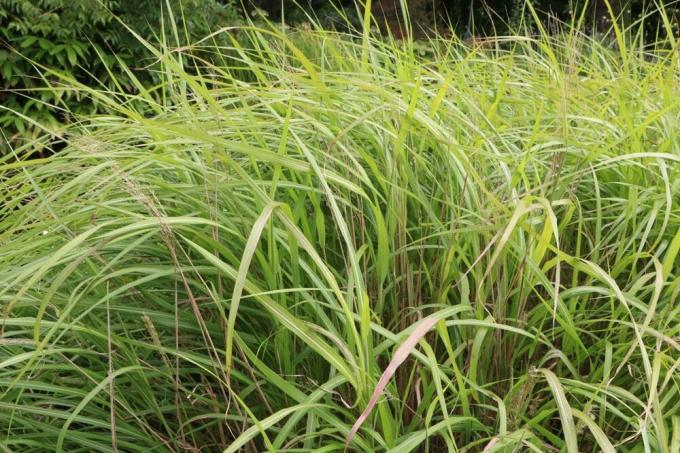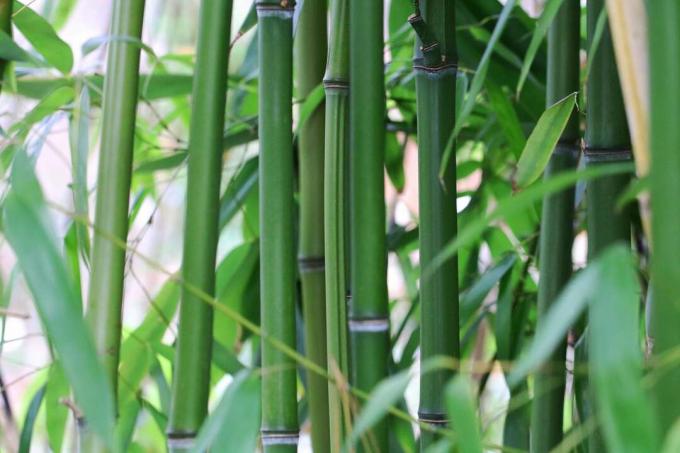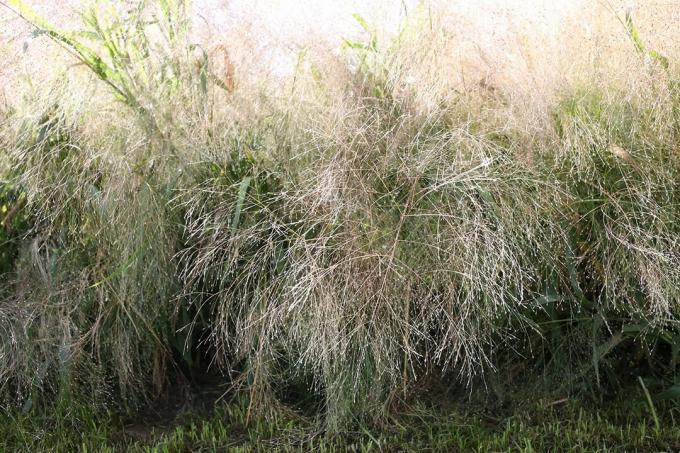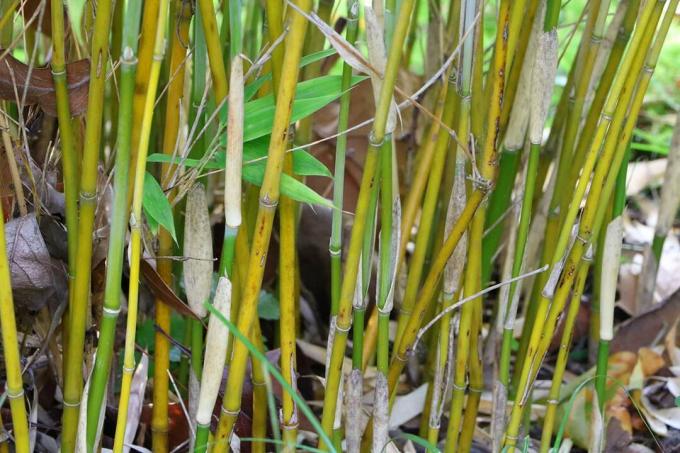

Table of contents
- Appearance of Miscanthus Giganteus
- Location for giant Chinese reed
- Planting tips
- Care of the giant Chinese reed
- Propagation of the giant reed
- Avoid care mistakes
- Worth knowing about the giant Chinese reed shortly
- Use of giant Chinese reed
- What to consider when growing and caring for Chinese reed
Giant Chinese reed (Miscanthus giganteus) in German "big stem blossom grass" belongs to the family of sweet grasses. As the name suggests, this perennial plant is characterized by rapid growth of up to 5 cm per day. It reaches an amazing height of up to four meters in a short time. This makes the plant one of the largest of its kind.
In the meantime, giant Chinese reed is also increasingly being used as an energy crop because of its rapid growth.
Appearance of Miscanthus Giganteus
This ornamental grass grows dense and tall, impresses with its light and transparent appearance and is extremely robust. So it can be used as a natural privacy screen in open borders or pebble beds. As it grows it is light green with a white midrib and in autumn the leaves take on a golden yellow colour. Winter gives the grass a fairytale, graceful appearance with hoarfrost.
Location for giant Chinese reed
Sunny to semi-shady places are particularly suitable for Chinese reed. The plant likes moist, humus-rich loamy soil that is not prone to waterlogging and contains little sand.
- Location as sunny as possible.
- light shade is well tolerated.
- a lot of shade produces weak growth and little flowering.
- moist, deep soil without waterlogging.
Planting tips
Sowing should take place at a soil temperature of 20°C, the soil must be kept moist. If the plant forms leaves after a germination period of at least three weeks, it can be planted out in May. Young plants also prefer this planting time outdoors. The planting distance should not be less than one meter. The grass forms rhizomes, i.e. long horizontal roots that form new seedlings at a distance from the mother plant. There is no need for a rhizome barrier because the roots are not rampant.
- nutrient-rich and humic soil
- Enriching the soil with compost increases the moisture content
- Moist but slightly permeable soils are ideal
- drainage should be as permeable as possible
- standing water damages the plant
- compacted soil structure is unfavorable
- keep at least one meter planting distance
- Chinese reed can be combined well with phlox, coneflower or torch lilies
- Regular weed plucking is a must when planting new trees
- Rhizome barriers against Chinese reed are only necessary for adjacent, high-maintenance green areas
Care of the giant Chinese reed
Chinese reed is easy to care for. For planting, it should be watered daily for three months. After that, this is only necessary when it is dry. You can safely do without fertilization, the plant grows perfectly well without artificial nutrients. Young plants need at least two summers to flower. Flowering time is September after the warm summer months. The grass is hardy and insensitive to frost and cold. A cut back to about 10 cm should only be done in spring, when the days are getting warmer again. The dry, above-ground leaves ensure sufficient winter protection. In addition, the nutrients migrate back into the roots, which ensures vigorous budding in spring.
- freshly planted reeds, Water the young plant a lot and sufficiently
- Soil should always be moist
- fertilization is only necessary in nutrient-poor soils
- young plants must not be fertilized
- Cut back 10 cm above ground level in spring - cut back in autumn causes rot
- is sufficiently hardy
- Tie leaves and stalks together to protect against wind and snow loads in winter
Propagation of the giant reed
Propagation is recommended in the spring after pruning by dividing the clumps with a spade. You dig up the divided grass and immediately plant it elsewhere so that new roots can quickly grow here. Self-sowing is only possible in autumn at locations with a high radiation level.
- March, April by division of the rhizomes
- September by self-sowing after a sunny summer
Avoid care mistakes

Weeds are poisonous for Chinese reed in the year of planting. So pluck weeds regularly to guarantee the best possible planting start. You should ensure that the plant is sufficiently declared in order to obtain specific information about the variety of Chinese grass. Also important: Always pay attention to the space required by the perennial so that it can spread comfortably according to its type. A maximum of four plants per square meter with a distance of half a meter between them is a golden rule.
- Flowers: beige or strong red-brown, feather-like, large flower spikes, usually only appear in very warm summers
- Flowering time: September to November
- Leaves: Arching, overhanging, yellow to light brown autumn colour, broad-leaved
- Growth: Strong, upright growth, clump forming
- Growth size: up to 4 meters high, up to 2 meters wide
- Location: sunny-half-shady
- Soil: loamy-humic, fresh, loose soil in which the plant can spread well
- Special feature: fast, strong growth after each pruning
- Hardiness: very frost hardy and cold resistant
- Use: privacy plant, solitary plant, windbreak, hedge plant, around ponds, as a container plant in dry gardens, leading perennial in mixed planting
- Space requirement: 1-3 pieces per square meter, row planting; 2-4 pieces per meter
- Life expectancy: at least 20 years with little maintenance
Worth knowing about the giant Chinese reed shortly
Giant China Grass acts as a deciduous solitary plant as well as in the row as a view and wind protection extremely decorative. It grows fast and upright, has impressive reed-like foliage and is really easy to care for and hardy. In combination with evergreen perennials and shrubs, it is the ideal designer for ponds and ponds, enriching every garden with its graceful and accentuated growth. As a dry plant, it can serve as an insect hotel for wild bees or be tied to mats for wind and sun protection. It also cuts a fine figure as a container plant on the balcony or terrace. Over the years, Chinese reed becomes more and more expressive in terms of color and structure of the leaves and flowers.
Use of giant Chinese reed
The Chinese reed has a variety of uses:
- It is suitable for close planting as an excellent privacy screen.
- Smaller varieties are often used as background or border planting of shrubbery and perennial borders.
- Even agricultural use as fiber for paper, pot and board production is possible.
There are many different varieties. So they differ considerably in size. during that M sin 'Yakushima Dwarf' only 100 cm high M floridulus up to 300 cm. There is also something for almost all tastes in terms of leaf shape. There are varieties with variegated white leaves (“Variegatus”) with yellowish striped leaves ("Zebrinus"), which has a silver gutter ("silver feather"), but also reddish colored leaves ("Dronning Ingrid"). The spikes bloom in a silvery-white, brownish or reddish colour. But there are also some varieties that do not flower here, such as B. the giant reed or the eulalia grass.
Incidentally, the benefit of Chinese reed is not limited to its decorative function in your garden. He also gives you some material for the floral decoration in the house: you can cut off his inflorescences like cut flowers and use, and the reed itself also holds up quite well in the vase and can be used as the basis for many magical floral works of art be used. The remnants of your Chinese reed, which the cut provides in the spring, are then chopped up to make another one excellent peat substitute, which gives the potting soil of your indoor plants the necessary permeability gives. If you have a lot of specimens of this beautiful reed plant in the garden, it is probably worth checking whether the chaff of your kind, such as Miscanthus giganteus, can be used for mulching or as bedding for a wide variety of pets can.
What to consider when growing and caring for Chinese reed
- The low-maintenance Miscanthus could run into trouble if soil is very compacted, so plan ahead for a season of green manure.
- As already mentioned, Chinese reed, which comes from swamps and damp meadows, likes slightly damp soil Dearest, especially the newly planted plants must therefore be additionally watered in case of doubt become.
- The young plants are sensitive to competition at first, so weeds should be controlled carefully.
- If the Chinese reed feels really good, it can also have its disadvantages: After a few years, it forms extensive rhizomes that produce new plants all around.
- This can be critical, if you want the Miscanthus to stay in its place permanently, you should consider putting it in the ground in a mortar bucket.
- If a Chinese reed spreads in the wrong place, you can usually stop it by constantly cutting it down to the ground, then it no longer has any strength left for the rhizome formation.
 garden editorial
garden editorial I write about everything that interests me in my garden.
Learn more about ornamental grasses

cutting bamboo | When and how to cut back bamboo?
Be it as a hedge, solitaire or ground cover, bamboo can be seen more and more often in home gardens. Because the sweet grass is easy to care for and easy to grow. However, the latter can quickly become a problem if the plants are not pruned regularly.

11 Tips for Cutting Grasses | Tools & Co.
Cutting ornamental grass works best with our tips: From choosing the right tool to right time - we have the most useful tips and tricks for you for the annual grass cut summarized.

Switchgrass, Panicum virgatum: Care from A – Z
Switchgrass is an upright-growing, clump-forming grass with narrow leaves. The species is considered to be easy to care for and makes few demands on location and soil. Read how to optimally plant and care for Panicum virgatum.

Zebra grass, Miscanthus sinensis 'Strictus': care from A - Z
In botanical jargon, zebra grass is also called Miscanthus sinensis 'Strictus'. The plants can be used wonderfully as privacy screens and are decorative. From care in the tub to overwintering: You can find information on care from A - Z here.

Grow pampas grass from seeds: we explain how
Pampas grass is considered easy to cultivate and can be successfully propagated by breeding. Under controlled conditions in the planter, the germination success is higher than with direct outdoor sowing. The procedures regarding substrate, choice of location and care hardly differ in these variants.

Grasses as a privacy screen: 20 tall grasses
Numerous grasses are ideal as privacy screens! We present the 20 most popular grasses in this article!



